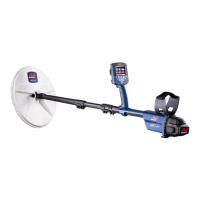Detecting Basics
33
• Undesired high ferrous target – iron nail
• Desired nonferrous target – gold coin
• Undesired nonferrous target – pull-tab
• Desired target – gold nugget
Detector Sounds
Turn the detector on. The constant background ‘hum’
produced by the detector is called the Threshold.
Variations in the Threshold allow you to hear very small
and deep targets. It is also used to help distinguish
between desired and undesired targets.
The detector may also produce false signals (Noise) when
not over the ground or with the coil held motionless.
These may not be target signals, but surrounding
electromagnetic interference (EMI). You can minimise
false signals by performing a Noise Cancel (page 17),
performing a Ground Balance (page 20), or by reducing
the Sensitivity of the detector (page 18). It is generally
better to try to reduce false signals by adjusting Noise
Cancel and Ground Balance before resorting to reducing
the Sensitivity.
Sweep the coil across the targets one at a time. Observe
the Detect screen and listen to the sounds of the detector
as it passes over each object. The audio response will give
you detailed information about the Target.
An audio signal is the sound produced by the detector
when a target is detected. Large targets or targets close to
the ground surface emit louder signals.
Very large objects close to the coil may overload the
detector electronics. When this happens, the detector
displays an overload message and emits a fading sound,
which repeats until the coil is moved away from the
source of the overload. Overloading is not harmful to the
electronics of the detector.
It is best to operate the detector only when outdoors and
away from sources of electromagnetic interference (EMI)
such as power lines and phone towers. These sources
may cause the detector to perform erratically, giving
false signals. There are also many metallic objects inside
a house, such as nails in the floor, reinforcing in the walls,
televisions and other household appliances, that might
interfere with or overload the electronics of the detector.
It is important to understand the sounds produced when
you make a valid or invalid button press. You will usually
encounter these sounds while adjusting settings via the
main menu. A valid button press makes a ‘bip’ sound; an
invalid button press makes a ‘ba-dump’ sound.
Each time you turn the detector on, the last screen used
before shutting down will appear. For example, if the
GPZ 7000 was operating in the Menu screen when turned
off, this screen will appear when the detector is turned
back on.
Detecting Tips and Techniques
Follow these hints and techniques to help you to utilise
the power of your GPZ 7000 detector, to ensure that every
trip is a success.
• Metallic targets will usually give a ‘solid’ sounding signal
when the coil is swept across the object from any
direction. A metallic target generally produces a short,
sharp and mostly symmetrical signal. Ground noises
usually give a broad uneven signal when the coil is
swept from different directions, and often may only give
a signal from one direction and no signal on the return
sweep.
• If you are not sure if the sound is ground noise or a
target signal you should always investigate. Scrape a
shallow hole about 30mm (1”) deep over the suspected
target. Sweep the coil over the hole at the original
ground level. Do not dip the coil into the hole. If the
signal has decreased in volume or is less defined it is
probably ground noise. If the signal remains the same,
or becomes louder, it is likely a metallic target. If you are
still not sure make the hole deeper and repeat
the process.
• A ‘halo effect’, which may be built up around a buried
metal object, makes the object appear to be larger to
the detector than it actually is. This will be reduced
once the target is disturbed from its position in the
ground (e.g. a small object, detected at a substantial
depth, may be more difficult to detect once disturbed
from the ground and lying in the loose dirt. If the object
is re-buried the ‘halo effect’ will not be present).
• Do not try to eliminate what might appear to be a
faint, isolated ground noise by balancing the detector
over the target; you may be ‘balancing out’ the target
response from a deeply buried metallic target. It is
better to Ground Balance around the target, without
going across it, then switch to Fixed and try Pinpointing.
• Dig all target signals, even in previously detected areas.
The GPZ 7000 has superior ground balancing and depth
so it is possible to find new targets in well-worked areas
where other detectors have been unable to cope with

